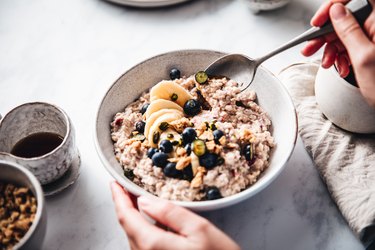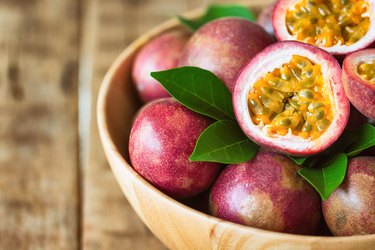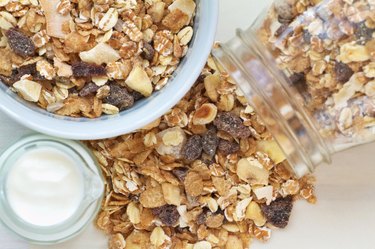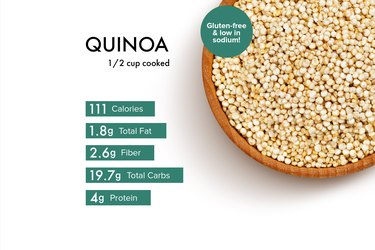
You've heard that eating fiber is good for you, but did you know different types of fiber have different benefits?
For example, soluble fiber — such as beta-glucan — can help lower cholesterol levels in the blood. Insoluble fiber, on the other hand, doesn't bind to cholesterol, but instead helps keep stool running smoothly through your intestines, per the Mayo Clinic.
Video of the Day
Video of the Day
Beta-glucan, or β-glucan, is a type of dietary fiber linked with a number of health benefits, per a September 2017 report in the International Journal of Molecular Sciences, including:
- Reduced risk of heart disease
- Lower total and LDL ("bad") cholesterol
- Slower growth and spread of cancer cells
- Less inflammation
- Immune health
One of the most researched benefits of beta-glucan is its effect on blood cholesterol levels.
Here's how it works: Beta-glucan can attach itself to bile acids and excrete these acids from the body. Bile acids are generated by the liver using the body's stores of cholesterol. When they're expelled from your body, your liver uses up more cholesterol to make new bile acids. That, in turn, leads to lower cholesterol levels, according to a July 2012 review in Comprehensive Reviews in Food Science and Food Safety.
So how much beta-glucan do you need? There's no established Daily Value (DV) for this fiber. But eating 3 grams per day of beta-glucan from oats or barley is linked to a reduced heart disease risk, according to the Food and Drug Administration (FDA)
You can get about that much in 1.5 cups of cooked oatmeal or barley.
To make sure you're getting enough, make sure your diet is rich in products on this list of foods with the highest beta-glucan content.
1. Oats
- Serving: 3.5 ounces
- Beta-glucan: 3 to 8 grams
Oats are among the richest sources of beta-glucan, and perhaps the most studied beta-glucan food source. Oats are associated with a number of benefits, such as reduced total and LDL cholesterol levels, heart disease risk and blood sugar levels.
Try them in these high-fiber oat dinner recipes (yes, you can enjoy oats any time of the day). If you're strapped for time, overnight oats may be your best bet.
2. Barley
- Serving: 3.5 ounces
- Beta-glucan: 2 to 20 grams
Barley and oats compete for the number one position for the highest beta-glucan content. Barley can contain as much as 20 grams of beta-glucan per 3.5 ounces.
A June 2016 study in the European Journal of Clinical Nutrition found eating 6.5 grams to 6.9 grams per day of barley β-glucans reduced total and LDL cholesterol by 7 percent in people with normal and high cholesterol levels.
To reap the cholesterol-lowering effects of this cereal grain, try cooking barley in a slow-cooker for a mostly hands-off meal.
3. Reishi Mushrooms
Reishi mushrooms are rich in beta-glucan (although exact estimates are hard to come by). They're also considered medicinal mushrooms — along with maitake, shiitake and chaga mushrooms — because of the many health-promoting benefits they offer.
Reishi mushrooms might strengthen the immune response and help your body fight against bacteria, viruses and other harmful compounds, according to Memorial Sloan Kettering Cancer Center. In animal lab studies, beta-glucan in reishi helped stop or slow the growth of cancer cells and prevented them from spreading.
This mushroom is often made into powder and is commonly added to tea or coffee.
4. Shiitake Mushrooms
- Serving: 100 grams, dried
- Beta-glucan: 20 to 30 grams
Shiitake mushrooms are another beta-glucan food source that you can easily add to your diet in dishes like stir-frys and soups.
These mushrooms are sometimes recommended during cancer treatment due to their anti-tumor effects. They have also been found to lower blood pressure and cholesterol levels, per a September 2014 study in Mycobiology.
5. Nutritional Yeast
- Beta-glucan: 30 percent of dry weight
If you follow a plant-based diet, you may already know about (and love) nutritional yeast, also known as nooch. It's rich in beta-glucan, and, more interestingly, the specific type of beta-glucan found in yeast has immune-supporting effects, per an April 2014 study in Nutrition Journal.
Nutritional yeast is also an excellent source of many B vitamins, such as vitamins B6 and B12, folate, thiamin, riboflavin and niacin, per the USDA. Considering vitamin B12 is mostly found in animal products, people following a vegan or plant-based diet may have trouble meeting their vitamin B12 needs without a supplement, per the National Institutes of Health (NIH) — that's where nooch can help.
Try adding nutritional yeast to these plant-based recipes for a cheesy taste without the cheese.
6. Seaweed
Seaweed is quite nutritious and rich in beta-glucan, especially brown seaweed such as kelp. The beta-glucan extracted from brown seaweed has anti-tumor and immune-strengthening properties, according to a September 2017 review in the International Journal of Molecular Sciences. The exact amount in a serving is tricky to determine and varies by type of seaweed.
Seaweed is also one of the best food sources of iodine. About 1 tablespoon (10 grams) of nori (a type of seaweed) contains 155 percent of the DV of iodine, per the NIH.
7. Rye
- Serving: 3.5 ounces of grain
- Beta-glucan: 1.2 to 2.7 grams
Oats and barley have the highest beta-glucan content, but other whole grains — like rye, wheat and sorghum — are also rich in this prebiotic fiber.
A 3.5-ounce serving of rye contains 1.3 grams to 2.7 grams of β-glucan, per research in the Journal of Nutrition and Metabolism. Try it in rye bread for your next nutritious sandwich.
8. Whole-Wheat Bread
- Serving: 3.5 ounces of grain
- Beta-glucan: 0.5 to 1 gram
Wheat is certainly not as high in beta-glucan as some other grains, but it still contains a fair share.
A 3.5-ounce serving of wheat contains 0.5 grams to 1 gram of beta-glucan. Meanwhile, the same serving of sorghum contains 1.6 grams to 6.2 grams. Rice also contains beta-glucan, but only a tiny amount — 0.13 grams per 3.5-ounce serving.
Make sure you're eating whole-wheat bread (rather than just brown bread) to reap the benefits.
- Mayo Clinic: "Dietary fiber:Essential for a healthy diet"
- International Journal of Molecular Sciences: "Clinical and Physiological Perspectives of β-Glucans: The Past, Present, and Future"
- Comprehensive Reviews in Food Science and Food Safety: "Oat Beta-Glucan: Its Role in Health Promotion and Prevention of Diseases"
- FDA: "Specific Requirements for Health Claims"
- Journal of Nutrition and Metabolism: "Beta Glucan: Health Benefits in Obesity and Metabolic Syndrome"
- European Journal of Clinical Nutrition: "A systematic review and meta-analysis of randomized controlled trials of the effect of barley β-glucan on LDL-C, non-HDL-C and apoB for cardiovascular disease risk reduction"
- Memorial Sloan Kettering Cancer Center: “Reishi Mushroom”
- Mycobiology: “Determination of Glucan Contents in the Fruiting Bodies and Mycelia of Lentinula edodes Cultivars”
- Nutrition Journal: “Immune-modulatory effects of dietary Yeast Beta-1,3/1,6-D-glucan”
- National Institutes of Health: “Vitamin B12 Fact Sheet for Health Professionals”
- International Journal of Molecular Sciences: “Overview of β-Glucans from Laminaria spp.: Immunomodulation Properties and Applications on Biologic Models”
- NIH: “Iodine Fact Sheet for Health Professionals”
- Nutrients: "Edible Mushrooms and Beta-Glucans: Impact on Human Health"
- Carbohydrate Polymers: "Soluble β-1,3/1,6-glucan in seaweed from the southern hemisphere and its immunomodulatory effect"



